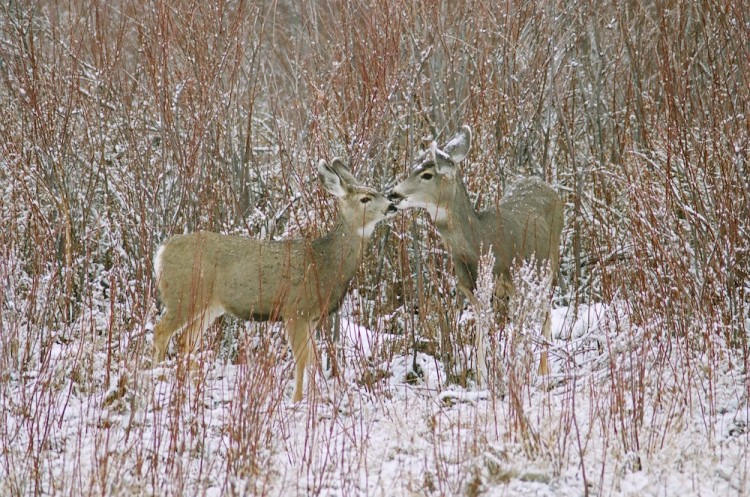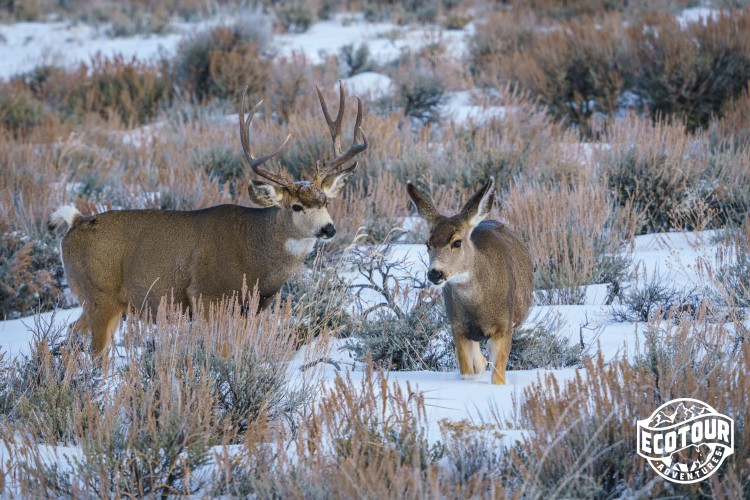Research Revealed: Mule deer & winter mortality

Pronghorn antelope weren’t the only ungulate species to suffer a brutal winter this year. Mule deer also experienced massive die-offs, so much so that researchers are wondering how the population will recover. The University of Wyoming’s Monteith Shop is a research lab run by professor Kevin Monteith, and this lab has spent years trapping, radio-collaring, and closely monitoring the Wyoming Range Mule Deer Herd. The Wyoming Range is a mountain range south of Jackson, WY located along the western border of the state, and it is known for having excellent mule deer habitat.

Photo by Josh Metten.
After a historic winter–record-breaking snowfall with brief warming periods that melted snow only to refreeze it and make food access and travel all but impossible–the herd has dwindled to a fraction of its normal size. In early June, Monteith reported that approximately 70% of the mule deer herd’s collared does had died, 60% of collared bucks had died, and 100% of collared fawns born in 2022 had died. These numbers are staggering, but surprisingly, they could have been worse. Going into this winter, the average body fat percentage was 12%. The last brutal Wyoming winter that saw massive mule deer die-offs was 2016-17, when deer had only 8% body fat going into the winter.
The Wyoming Range Mule Deer Herd has hovered around 30,000 animals ever since that previous bad winter. The Wyoming Game and Fish Department does annual flight surveys to count mule deer, but not until after the fall hunting season. It’s impossible to say what the current herd numbers are, but biologists are estimating around 10,000.
The hunting season targets only antlered bucks, leaving the does to reproduce and rebuild the population. Productive does can regrow the herd by a rate of about 20%. However, the fawns born this spring from the withered, weakened does will be plagued by the effects of this past winter for the rest of their lives. It is expected that most of the 2023 fawns will not survive more than a few months or even weeks, but the ones that do will have smaller bodies and smaller antlers, for life.
A couple of other factors affecting the survival and growth of the herd will remain in play. The herd will face increased pressure from predators due to the reduced prey base predators have to choose from. Additionally, the loss of so many individual deer who knew migration routes–migration routes are passed down through the generations–will lead to a reduction in the use of prime mule deer habitat, meaning surviving deer will not build up as robust fat stores as they have in years past.

Photo by ETA General Manager Tenley Thompson.
Biologists are now grappling with many questions surrounding the management of the surviving Wyoming Range Mule Deer Herd. Do they increase hunting tags for predators like black bears and mountain lions? Do they translocate surviving deer to prime habitat areas? Should everything be left alone; will natural recovery take place?
One promising aspect of this brutal winter is that the higher precipitation will lead to better food on the deer’s summer range, which will aid in building fat stores for the winter. Surviving does without fawns will expend more energy feeding themselves rather than rearing young, making them healthier for the next mating season. There is a bit of a light at the end of this very dark tunnel. Now, only time will tell how this mule deer herd will bounce back.













